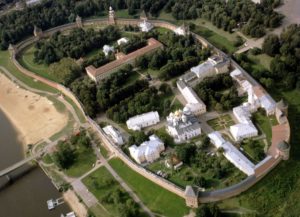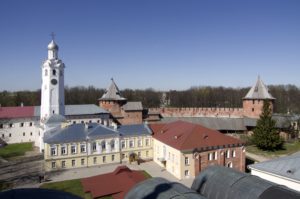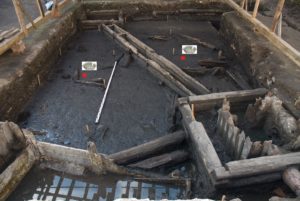Marina Anatol’evna Rodionova
Novgorod State Museum
Iakov Viktorovich Frenkel’
State Hermitage Museum
Histories of the “Silk Roads” generally have devoted too little attention to evidence about Eurasian exchange found in the northern reaches of Eastern Europe. Much has been written about the significant flow of Middle Eastern and Central Asian silver into that region during the Viking Age without necessarily connecting it to broader aspects of Silk Road history. Other evidence—for example, textiles, glass, and ceramics—is rarer, but can reveal a great deal about interactions with the East involving medieval towns such as Novgorod, whose connections with the Hanseatic league form a significant chapter in the history of European trade. Even a single find, such as a Chinese celadon recently unearthed in the Novgorod Kremlin, sheds light on larger patterns of exchange, in this case ones dating to the period of Mongol rule over the Russian lands. The discussion here opens with an overview of Novgorod’s early history and the city’s important place along the trade routes, then proceeds to analyze in detail the celadon in order to pinpoint its origin, and concludes by contextualizing it with reference to other evidence about the dissemination of such celadons and the widespread interest in its decorative motif of two fish.
Novgorod in Early Russian History
Novgorod is one of the most ancient of Russian cities with a thousand-year history. It arose on the shores of the Volkhov River not far from its source at Lake Il’men in the northwestern territory of Ancient Rus [Fig. 1].
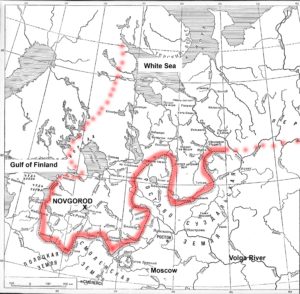
Fig. 1. The Novgorod lands in the second half of the 12th to the first half of the 13th centuries. (After: A. N. Nasonov “Russkaia Zemlia” i obrazovanie territorii Drevnerusskogo gosudarstva [Moskva, 1951]: foldout facing p. 96)
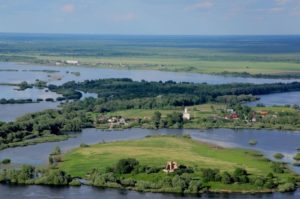
Fig. 2. View of Rurikovo Gorodische (lit. Rurik’s Hillfort). (After: Agency «Sherif», www.novgorod.ru)
Novgorod’s subsequent development as a significant political, economic, and cultural center is to be connected with the place it occupied as part of what we call the Early Russian State, whose political and religious center was established in Kiev (Ianin 2013: 11). The conversion to Byzantine Orthodox Christianity by Kievan prince Vladimir Sviatoslavich in the late 10th century led to the establishment of several bishoprics in the regional princely capitals, one of the most important of them being Novgorod, where the new location of the town was to be the Christian center. That location—the fortress—was one of the elevated areas on the left bank of the Volkhov, which, as archaeology has demonstrated, was already settled by the third quarter of the 10th century [Fig. 3].

Fig. 3. A drawing based on the depiction of late medieval Novgorod on an icon of “The Sign of the Mother of God.” The Kremlin side of the city is below, with a double ring of fortifications, the inner one containing the archbishop’s residence and cathedral. The “trading side” of the city (east of the river) is at top. (After: А.F. Vеltmаn, “O gospodine Novgorode Velikom” [About Novgorod the Great]. Моskva, 1834)
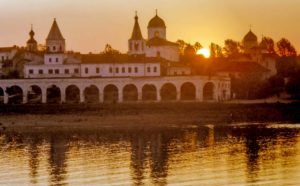
Fig. 4. Sunrise view across the Volkhov to the “trading side” of Novgorod, with the remains of the row of merchants’ shops built in the 18th century. The prince’s church of St. Nicholas, built in 1113, is in the upper center, shown here prior to its modern restoration. (Photo taken in 1968, courtesy of Daniel C. Waugh)

Fig. 5. The Church of St. Nicholas in the prince’s court, here restored to its original five-domed appearance. View from the southeast. The porch on the left was added in modern times. (Photo courtesy of Daniel C. Waugh)
Later, as the relationship between the princes and the city changed, the princely residence would return to the hillfort. Novgorod continued to develop after Iaroslav succeeded to the throne in Kiev. In 1044, fortifications (the Kremlin) were erected on the left bank of the Volkhov at the same time that the re-building of the Cathedral of Sancta Sophia as a stone structure began (NPL 1950: 181) [Figs. 6, 7]. The fortifications enclosed the archbishop’s court, which adjoined the cathedral [Fig. 8].

Fig. 6. The Novgorod Kremlin at sunrise, view from the northeast looking across the Volkhov River in 1968. (Photo courtesy of Daniel C. Waugh)
Novgorod’s hinterland extended way to the north and east, embracing resource-rich forested areas which were the source of furs, honey, and salt and where some agriculture could be developed profitably despite challenging ecological conditions. In the 11th and 12th centuries, Novgorod’s position as the northern outpost on the “route from the Varangians to the Greeks” meant that economic ties with Kiev and beyond to Byzantium were especially important [Fig. 9].
The precise chronology which archaeology has documented concerning trade in such items as glass beads, bracelets, and walnuts illustrates the rise and eventual decline in this route. As early as the late 11th century, merchants from Gotland in the Baltic established an outpost in Novgorod; relations with the German trading cities that would eventually form the Hanseatic league continued to develop and eventually were formalized with treaties (Rybina 2009). The trade with the West flourished in the 13th–15th centuries, despite the Mongol conquest of the other Russian principalities.
In the history of early Rus, Novgorod developed a distinctive set of political institutions, often termed a “republic”. By the 12th century, princely power in the city was limited by treaty. The popular assembly (known as the veche) had some say in policy, but the real secular power came to be vested in an oligarchy of wealthy families, from whose members the mayors (posadniki) of the city were selected (Ianin 2003: 7–8). Foreign and domestic politics were under the control of the archbishop, even though Novgorod was not a theocratic state. The Novgorod archbishop occupied a particularly prominent position in the Orthodox church hierarchy in Russia, contributing to the fact that, with the decline of the Kievan state, Novgorod would retain its independence down to the point when it was incorporated into Muscovy in the late 15th century.
Medieval Novgorod has always attracted the attention of scholars, in part due to the richness of cultural documentation, better preserved there than in any other prominent old Russian city. Since the city was never sacked by the Mongols, a significant portion of the manuscript books left to us from early Russia survived there, including the oldest dated book of the Gospels and the oldest manuscript of a Russian chronicle. Indeed, the extent and continuity of the tradition of chronicle writing in Novgorod are one reason we can document the city’s history so precisely. Novgorod also is the location of the oldest preserved masonry church in Rus, the Cathedral of Sancta Sophia [Fig. 10].
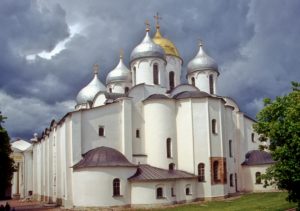
Fig. 10. The Cathedral of Sancta Sophia (1045-1050) from the east. (Photo courtesy of Daniel C. Waugh)
A large number of other churches were still standing down into modern times, decorated in many cases with some of the best preserved mural paintings and from which some of the oldest and most important icons have survived. No other old Russian city has as complete a collection of monuments of architecture and monumental painting. Of all the buildings of Ancient Rus of the 11th–15th centuries which have come down to the present, nearly half belong to the Novgorod school.
Arguably the most important contribution to our knowledge about Novgorod has come from archaeology [Fig. 11]. Novgorod has been studied more than any other early Russian city (Thompson 1967; Brisbane 1992; Brisbane and Gaimster 2001; Brisbane et. al. 2012). It became a kind of unique archaeological training ground where the methodology of excavation of urban settlements over wide areas was developed. The first regular excavations with the goal of a comprehensive scientific study of the cultural layer of Novgorod began in 1932. The richness of archaeological documentation is due to the fact that the water-saturated cultural layer, in some places as thick as 9 to 10 meters, has preserved beautifully organic materials. As was true of other medieval Russian cities, residential housing was largely made of wood; frequent fires (whose dates often can be established precisely from the chronicles) meant that houses were re-built on top of the remains of the earlier ones. As the level of debris in the streets rose, and given the muddy ground, Novgorodians laid down log walkways, which then were renewed every two or three decades [Fig. 12]. Analysis of tree rings for dating (dendrochronology) has thus made it possible to date more precisely than might be possible by other methodologies each of the nearly 30 strata in the deepest cultural layer of the city, starting in the late 10th century and going down into the 15th.
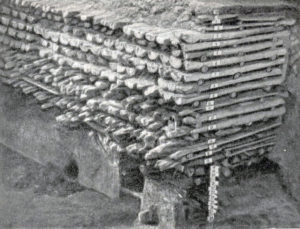
Fig. 12. Nerevskiy archeological dig of 1951-1962. Pavement cut of Velikaya street (After: B.А. Коlchin and V.L. Ianin, “Arkheologii Novgoroda 50 let” [Fiftieth anniversary of Novgorod’s archeology]. Моskva, 1982: 30, fig. 9)
The damp soil preserved a huge range of objects of everyday life: wooden dishes (some clearly turned on lathes) and table utensils, leather footwear, toys, chessmen, votive figurines, iron padlocks, and knives made of a sophisticated amalgam of hard and soft metal. Plant remains and animal bones provide a good idea of the local diet and how it changed over time, the evidence attesting in part to the importance of long-distance trade in valuable products not produced locally. While some of the most significant trade items (for example, the furs) are no longer extant, there is plenty of evidence regarding commerce: scales, weights, and enough of the remains of boats to suggest that many of them had a very substantial cargo capacity.
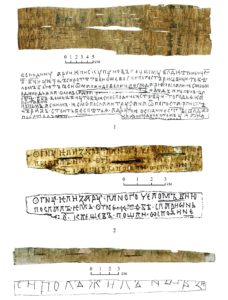
Fig. 13. Birchbark document Nos. 963, 964, and 965, from the Kremlin excavation. No. 963 dates to 1416-1421 and is addressed to Archbishop Simeon, who occupied the see in those years. No. 964 is dated to the 1340s-1390s, and No. 965 to the period from 1349 to the 1360s. (After: Rodionova 2017: 79, fig. 30)
Among the most spectacular of the archaeological finds are those related to writing. Beginning with the first discovery in 1951, more than 1,100 birchbark documents have been found, attesting to a much wider spread of literacy in the population than had been previously known [Fig. 13]. Not just the elite, but individuals in lower classes were literate. Women composed letters and received them; one set of the birchbarks illustrates the learning process of a child, who also, as children are wont to do, drew pictures and doodles. Taken together with the now meticulously documented graffiti scratched on the walls of the Cathedral of Sancta Sophia, the birchbarks attest to the wide range of functions for ordinary writing: personal letters, contracts, business correspondence, and much more. The birchbarks continue to be found in the ongoing excavations in Novgorod; their chronology can be established by the dendrochronology for the logs and beams of the layers in which they were preserved. The most striking recent find regarding writing in Novgorod was the discovery in 2000 of a wax-coated tablet on which was inscribed a portion of one of the psalms [Fig. 14]. The find has been dated to the end of the 10th or beginning of the 11th century, thus making it the earliest relatively securely dated example of substantial writing to have been found in early Rus.
By any medieval measure, Novgorod was a large and rich city which traded with both East and West. In it, a distinctive Christian culture formed, nurtured by Slavic as well as Byzantine sources. It was a center of book learning which served the needs of the numerous churches and monasteries and became a treasure house of old Russian applied arts and monumental painting. The ongoing archaeology in Novgorod continues to document ordinary aspects of daily life as well as highlight unique objects that may shed light on the socially prestigious areas of the city. The next section of our article is devoted to just such a find.
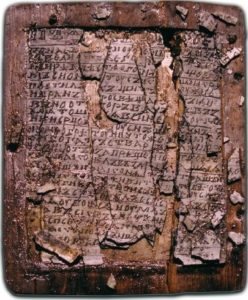
Fig. 14. The tablet with the text from the Psalms inscribed with a stylus on wax. (Photo courtesy of S.A. Orlov)
The Chinese Celadon Excavated in 2008
In 2008, an excavation within cultural layers of the 14th century in the Kremlin unearthed five charred fragments of a Chinese celadon vessel, which, referring to the find spot, we shall subsequently term “the dish of the episcopal court” [Figs. 15, 16, 17, 18].

Fig. 15. The excavation in the Episcopal court of the Kremlin. (Photo courtesy of E.V. Gordjushcenkov)

Fig. 17. The celadon dish from the episcopal court. Graphic reconstruction by L. A. Sokolova and T. V. Silaeva. (After: Rodionova 2017, fig. 143)
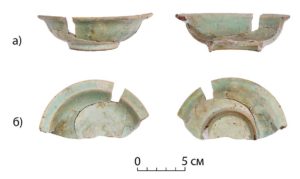
Fig. 18. The celadon dish from the episcopal court: a) side view; b) views from above and below. (After: Rodionova 2017, fig. 144)
While the range of distribution of Chinese medieval celadons is very broad (see below), Novgorod the Great is the northernmost location where excavations have uncovered such a ceramic. The previous finds of celadons in Novgorod consisted of small shards [Fig. 19] (Koval’ 1997a: 159, fig. 2; Rodionova and Frenkel’ 2012: 24, ill. 9; Rodionova 2017, fig. 149). The shards of this newly discovered celadon merit special attention, though, since it is possible to reconstruct the form of the dish and classify it with respect to existing typological schemes. Moreover, the context of the find allows us to date when it entered the cultural layer, and suggests that the last owner of the dish was likely a member of the religious elite of medieval Novgorod.

Fig. 20. A Southern Song celadon from Zhejiang province with the shape of that found in the episcopal court in Novgorod. (After: Fang 1964, 558, No. 4)
The fragments of the celadon were found on the boundary of the second (1340–1360s) and third (1300–1340s) horizons of the medieval building of the episcopal court, under charred wooden planking. Four of the shards can be associated with a burned building (structures 9 and 10), which dendrochronology indicates was erected in 1300. A fifth shard lay in the same stratigraphic horizon, four meters to the south. The juxtaposition of chronicle data about fires in the bishop’s court, the dendrochronological dates of the planks and building, the sphragistics (Ianin 1970) and numismatic finds makes possible an exact dating for the deposit of the celadon. In the fire of 1340, the celadon fell into the cultural layer; after some time the location of the fire of 1340 was covered by wooden flooring, which was subsequently damaged by fire in 1368.
The dish of the episcopal court is made of dense gray body and covered with a thick transparent glaze of a light gray-green color. The glaze does not extend to the bottom of the circular base which has a gray-brown color. X-ray analysis revealed in the body a high iron and titanium content. The glaze was made according to a lime alkaline recipe. The colorants were iron and titanium. The vessel has a broad horizontal rim and its bowl rests on a circular base. The exterior surface of the dish is decorated by poorly delineated vertical fluting, while the smooth interior surface of the walls is covered with dense crackle. In the central “medallion” (the inside bottom of the dish) is an underglaze relief depiction of two fish, placed head to tail to form a circle. There are various classification schemes which can be brought to bear in describing such celadons, beginning with observations about the external characteristics.
The diameter of the dish is a bit less than 13 cm, its height 4.5 cm., and the diameter of the circular base 5.5 cm. On the basis of the measurement formula devised by Evgeniia Ivanovna Gel’man, the dish of the episcopal court is to be classified as a dish of medium size designated by the generic term bei 桮 (“cup”) (Gel’man 1996: 12–13). In the dictionary of Chinese ceramic terms, dishes analogous to the dish from the episcopal court are named shuangyu xi 雙魚洗 (“twin-fish washer”) (Wang 2002: 90). In the specialist literature such dishes also are known as shuaqing xi 刷清洗 (“brush washers”), whereas the ones of larger size are lianpen 臉盆 (“wash basins”) (Zhu and Wang 1963: 38, fig. 12; Liu and Xiong 1982: 64; Yu and Mei 1989: 76; Gyllensvärd 1975: 104–5; Krahl 1994, 1: 299, No. 559). It is known that the Chinese art critic Wen Zhenheng 文震亨 (1585–1645) used such Longquan 龍泉 celadons with the guan 官 glaze for cleaning brushes (Kuz’menko 2009: 46).

Fig. 19. Two celadon shards found in Novgorod: 1) from the Trinity excavation; 2) from the Nerev excavation. (After: Rodionova 2017, fig. 149)
The form of the given dish corresponds to the fourth type of the forms of dishes found in excavations of the medieval Longquan ceramic kilns in Zhejiang 浙江 province (Fang 1964: 558) [Fig. 20]. According to the work of Jan C. Wirgin (1970: 81, 83-84) about the decoration of medieval Chinese celadons, the surface decoration of the exterior and interior of the dish is characteristic for Longquan celadons of types Lc9 and Lc10. On the basis of classification of Chinese celadons found in the Golden Horde city of Bolgary (Poluboiarinova 2003: 155–59), the dish from the episcopal court is to be classified as semi-spherical, of small dimensions, with a broad flanged rim, variant 2, without incising, and with relief underglaze decoration.
The “medallion” of the dish of the episcopal court is decorated with an underglaze relief depiction of two fish. Such a technique in Chinese ceramic production is called moyin tiehua 模印貼花 (“molded decal”) (Wang 2002: 213). The figures are prepared in molds and then attached to the surface of the vessel with a slip, after which they are covered with glaze. This technique, applied to celadons of the Song era, is mentioned in the late 18th-century work of Lan Pu 藍浦, Jingdezhen taolu 景德鎮陶錄 (Pottery Records of Jingdezhen) (Stuzhina 1970: 62). The common name for all the possible compositions of the figures of two fish in Chinese art is shuangyu, or “twin fish.” Such compositions in China indicate the wish for connubial bliss (Ayers 1985: 61; Krahl 1994, I: 299, No. 559; Vestfalen and Krechetova 1947: 37, pl. V) and numerous progeny (Lubo-Lesnichenko 1975: 26), a belief that likely helps explain the popularity of the motif in the arts developed under the patronage of non-Chinese dynasties such as the Liao in north China [Fig. 21].

Fig. 21. Two examples of Liao period (ca. early 12th century) gilded silver metalwork with the “twin-fish” motif. Photographed in a special exhibition in the Hohhot Museum, Inner Mongolia Autonomous Region, China. (Photos courtesy of Daniel C. Waugh)
The centrally symmetrical scheme of the “twin-fish” motif is characteristic in particular for celadons of the Longquan family [Figs. 22, 23] (Wirgin 1970: 83–84; Ayers 1985: 61, No. 38; Krahl 1994, 1: 299, No. 559; Wang 2002: 249) and become noteworthy from Southern Song times (Medley 1982: 150; Krahl 1994, 1: 298, No. 558). Other variants, including compositions with four fish arranged in a circle head-to-tail, are also known among Longquan celadons [Fig. 24].
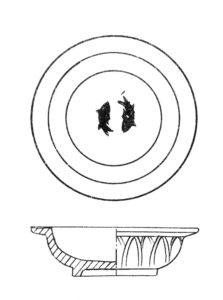
Fig. 22. The “twin-fish” motif in a celadon dish of the Longquan family. (After: Yu and Mei 1989, 78, fig. 11.1)
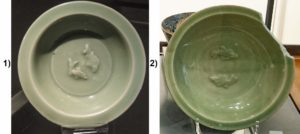
Fig. 23. Two Longquan celadons from Zhejiang province with molded “twin-fish” decoration: 1) from the collection of the Ashmolean Museum, Oxford, EA2008.16; 2) from the Macdonald Collection in the Durham (Eng.) University Oriental Museum, DUROM.1969.104.C. (Photos courtesy of Daniel C. Waugh)
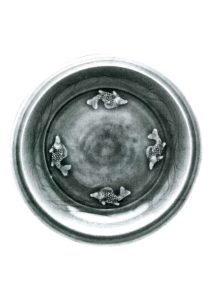
Fig. 24. A Longquan celadon dish with molded decoration of four fish. Late 13th or early 14th сentury. Topkapi Sarai Museum, Istanbul. TKS 15/209. (After: Regina Krahl 1986, vol. 1, 257: no. 65)
These external features then suggest that the celadon dish of the episcopal court corresponds most closely to the wares of the Lonqquan center of ceramic production in southwestern Zhejiang province in southern China (Wirgin 1970: 81–84; Wang 2002: 249). Moreover, analysis of the internal characteristics such as the composition of the ceramic body and the glazes offers further support.
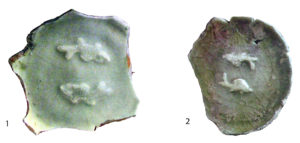
Fig. 25. Two Longquan celadon shards with the twin-fish motif from the excavations by Nils Palmgren in 1935–36. (After: Palmgren 1963: 113, ill 9; 117, ill. 8)
The making of celadons in Longquan began in the Northern Song period (Valenstein 1989: 102) and in other provinces of southern China (Krahl 1986: 33; Medley 1982: 147; Ryōichi 1990: 184). Thus a huge family of southern Chinese celadons is to be attributed to Longquan and has stylistic associations with the aesthetic of Longquan even if not necessarily made in the Longquan kilns. The Longquan kilns have been extensively studied by archaeologists (Hobson 1924: 23; Palmgren 1963: 7; Zhu and Wang 1963; Li 1985: 53). These excavations uncovered many celadons close to the example from the episcopal court (Palmgren 1963: 113, No. 9; 116–117, No. 8; fig. 28: 26) [Fig. 25]; Zhu and Wang 1963: 37, fig. 12; Fang 1964: 558; Wirgin 1970: 83). Archaeometric methods make it possible to distinguish the production of locally situated kilns within Longquan, and to distinguish shards of the Song, Yuan, or Ming periods (Li 1985; Xie et al. 2009).
The ceramic body of Longquan celadons consists of a mixture of kaolin-content “Chinese stone” and high quality clay. Early Longquan celadons have shards of gray color. From the mid-Southern Song period, the majority of the Longquan kilns which have been studied produced celadons with shards of white color, similar to porcelain (Arapova 1977: 31, n. 3; Gyllensvärd 1975: 94–95; Tokyo 1994: xvi). In the Yuan period, the shards of Longquan celadons again became primarily gray (Morgan 1991: 71), and under the Ming again approximated white (Fekhner 1956: 94, n. 3). In the first half of the Qing period genuine Longquan production was in decline, although in China and Japan porcelain imitations of Longquan celadons were being made (Arapova 1977: 20; Kanevskaia 2004: 8; Wood 2011: 76, 80–81).
In the early Song period, Longquan glaze was alkaline; from the Southern Song time, it was prepared according to a lime-alkaline recipe composed of quartz sand, limestone, and organic ash (Valenstein 1989: 99; Wood 2011: 78). The composition of Longquan glazes has been frequently analyzed, with the indication that over time the components even of the lime-alkaline glazes changed (Li 1985: 59, tabl. 5; Wood 2011: 76, 78). Longquan glaze was transparent or translucent. The color varied from blue (“the color of a duck’s egg”) to green-blue (“an ocean wave”) and various shades of the gray-green spectrum (up to “olive-green”) (Wood 2011: 77–78). At first the blue shade predominated; later it came to be replaced with gray-green. At the end of the Southern Song and beginning of the Yuan period the so-called “plum-green” glaze was used (Wang 2002: 163). The colorants were iron and titanium (in the bluish glazes, titanium was somewhat less than it was in the gray-green). The slightly matte appearance of the glaze was created by the combination of phosphorus present in the ash and the bubbles which formed in the glaze. For the attainment of a decorative effect, the glaze sometimes was covered with a network of crackling.
These indicated characteristics of the ceramic body and glaze of Longquan celadons of the Yuan period are exactly those found in the celadon dish of the episcopal court, thus supporting the other evidence that it was made in the Yuan period. This analysis corresponds well with the chronology established from the archaeological context of the dish.
The Spread of Longquan Celadons across Asia
Celadons of the Longquan style—dishes of medium and large size, plates, and saucers—whose décor is similar to the décor of the dish from the episcopal court, were widespread. The chronology of the circulation of such dishes embraces the date of deposition of the dish from the episcopal court obtained from independent sources.
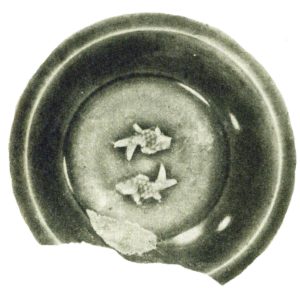
Fig. 26. A Yuan period Longquan celadon from a deposit found in the vicinity of Taojin. (After: Zhang 1987: 23, fig. 10)
Such celadons are found in China in excavations of the Longquan kilns of the Southern Song and Yuan periods (Palmgren 1963; Zhu and Wang 1963). There are a good many such dishes in deposits of ceramics from the Yuan period in the regions close to the centers of production. Thus in Jiangxi 江西 province, we know of two such deposits of the late Yuan period: a deposit found in Gao’an 高安 district (Liu and Xiong 1982: 62, 64–66, 68, figs. 16, 20) and one found in 1984 in the vicinity of the city of Lean 樂安 (Yu and Mei 1989: 76, 78, fig. 11.1; pl. 7). Yet another deposit with such celadons of the Yuan period was found in the vicinity of the city of Taojin 淘金 in neighboring Hunan 湖南 province (Zhang 1987: 21, fig. 1.10; 3, fig.10) [Fig. 26]. Moreover, the cargo of thousands of celadons in the cargo vessel that sank at Sinan off Korean in 1323 en route, apparently, to Japan included celadons of interest to us with the paired depictions of fish: “… pairs of fish in applique relief” (Ayers 1978: 80; Carswell 2000: 108).
Longquan celadons similar to the dish from the episcopal court were common not only in China during the Southern Song and Yuan periods but also widely across Asia and even into North Africa. Such celadons have been found in excavations in in Karakorum in Mongolia (Evtukhova 1965: 245); in Khara-Khoto (Rodionova and Frenkel’ 2012: 16, fig. 7; Rodionova 2017, ill. 145); in Iran (Morgan 1991: 70; pl. IV-d: A-D; pl. V-a: B, E; fig. 8: 36–50; fig. 7: 36, 44–45); in Fustat (old Cairo) in Egypt (Gyllensvärd 1975: 104–105; pl. 15.5–8; 110–111; pl. 27.1, 2); and in Southeast Asia (Wirgin 1970: 83; Gyllensvärd 1975: 111). Wherever it is possible to speak of more or less precise dating, such celadons date either to the Yuan period, or, in the case of Fustat in Egypt, more broadly, from the Southern Song to the Ming period. We note that such a dating somewhat differs from the dating obtained in the first instance on the basis of stylistic analysis.
Also known are pseudo-celadon imitations of such dishes made in the Near East [Fig. 27], where the evocation of the fish motif included stylistically similar versions with two, three, and even four fish. At least some of these probably were produced under the Mongol Il-khanids and their immediate successors in Iran.

Fig. 27. Middle-Eastern imitations of Chinese celadons with molded fish décor. Left to right: fritware dish, Iran, 14th century (Ashmolean Museum, Oxford: EA1978.2305); fritware, probably Iran, 14th century (British Museum: Godman Bequest, OA G284; OA 1931 2-17.1); fritware, possibly Nishapur or Tabriz (Iran), ca. 1450-1550 (Victoria and Albert Museum, London: C.10-1947). (Photos courtesy of Daniel C. Waugh)
Indeed, the range of distribution of Chinese medieval celadons, often with evidence for the impact they had on local ceramic production, is very broad—from the Russian Far East (Gel’man et al 1996: 166–67) to Indonesia and the Philippines in the southeast (Troinitskii 1911: 7; Kverfel’dt 1938: 189; Hobson 1924: 22), to the southwest in Africa south of the Sahara (Xia 1963: 17-19; Glukhareva and Denike 1948: 57; Carswell 2000: 64–65), to Western Europe (Kverfel’dt 1938: 191; Wood 2011: 80) and Ancient Rus in the northeast (Koval’ 2017: 758).
Celadons in Western Eurasia and Eastern Europe during the Yuan Period
On the territory of the former USSR west of the Urals, the earliest celadons from the end of the first millennium have been located in Transcaucasia, where they circulated through all of the Middle Ages (Kverfel’dt 1938; Shelkovnikov 1954; Abilova 1956). The first celadons arrived in Transcaucasia most probably from the Near East, where they in turn had arrived from the end of the first millennium as a result of Arab maritime trade (Shelkovnikov 1954: 368; Poluboiarinova 2003: 155). On the east side of the Arabian peninsula, the first Yue-Yao celadons (Krahl 1994, 1: 180) appear in the 9th–10th centuries (Pirazzoli-t’Serstevens 1988: 91–92, 105). At that time Yue-Yao wares appear as well in Transcaucasia (Shelkovnikov 1954: 371–72). As early as 1911, Sergei Nikolaevich Troinitskii wrote (1911: 7) about the coincidence of the presence of celadons outside of China proper and the presence of Chinese coins of the 10th–11th centuries. Later, Ernest Kondratovich Kverfel’dt noted (1947: 27) that “Arab merchants already in the 11th century brought them [celadons] for the first time to Europe under the Arab designation ‘martabani’.”
North of the Caucasus celadons began to appear in large quantities following the Mongol conquest at the end of the 13th century (Poluboiarinova 2003: 163; Mazurov and Koval’ 2004: 302), and the peak of their dissemination comes in the 14th to the beginning of the 15th centuries.
Yet an awareness of the fact that among the finds of Golden Horde and Early Rus cities of the late Middle Ages are celadons, and more generally Chinese imports, only gradually entered Russian scholarship. The first to discover Chinese ceramic imports in the ruins of Golden Horde cities in the 1840s was Aleksandr Vlas’evich Tereshchenko (1806–1865), a functionary of the Ministry of Internal Affairs, a member of the Archaeological Commission, and an extraordinarily accomplished amateur archaeologist. Beginning in the second half of the 18th century, scholars and administrators (e.g., Vasilii Tatishchev, Petr Rychkov, Samuel Gmelin, Ivan Lepekhin, and Johann Fal’k) had noted in the region along the Volga some grandiose ruins (Glukhov 2014: 92–93), which, as later became known, were the remains of Golden Horde cities. From 1843 to 1851, Tereshchenko, a graduate of Khar’kov University who held the rank of “Actual State Counselor,” studied one of these locations, the former capital of the Golden Horde (Saray Berke), located on the lower Volga. As Svetlana Borisovna Adaksina has noted (1993: 47), “these were the first large-scale excavations in Russia of a medieval city.”
In one of the volumes of the Notes of the St. Petersburg Archaeological and Numismatic Society describing his excavations, Tereshchenko wrote (1850: 382, 385–86) that in 1846 he had found “… broken faience and porcelain dishes with depictions on them of flowers and birds; … found under beams were faience and porcelain dishes, which, however, were already broken.” Apparently the following excerpt of his work pertains to celadon: “A faience dish of pale green color. It is noteworthy, as apart from its inherent distinction is the fact that until it was found, no complete objects of faience had been found which the Tatars must have obtained from China, with which they interacted. It is decorated with inscribed stripes and patterns …” (ibid.: 408). The celadon finds from Tereshchenko’s excavations were published in 2005 (Zolotaia Orda 2005: 233–34, Hermitage Inventory Nos. Sar-144, Sar-145 and Sar-156).
One should note that Tereshchenko’s finds of Chinese porcelain and celadon in a Golden Horde settlement did not lead to general recognition of the fact that fine Chinese ceramics were imported into the cities of the Golden Horde. Thus, in the Reports of the Society of Archaeology, History and Ethnography at the Imperial University of Kazan’ in 1878, appended to an article with the expressive title “On a remarkable Chinese coin of the end of the 10th or beginning of the 11th century, obtained in the village of Bolgary in August 1877,” was the following sentence from the pen of a professor of the capital’s university: “We have no information whatsoever regarding relations of ancient China with the lands that are Russia today” (Vasil’ev 1878: 123).
The situation began to change at the end of the 19th century. A deposit of Eastern dishes which included a whole series of celadons was discovered in the Moscow Kremlin under the floor of the Cathedral of the Annunciation (Fekhner 1956: 94). In a 1901 article about excavations at Akkerman (at the mouth of the Dniester River in Ukraine), Ernst Romanovich fon Shtern (1901: 40) singled out “… two pieces of a dish of ancient Chinese greenish turquoise (‘meer-grun’) ‘celadon-porcelain’… which, as is known, rarely made its way to Europe and therefore was highly valued.” In 1911, describing the porcelain gallery of the Imperial Hermitage, Sergei Nikolaevich Troinitskii provided a precise description of a Chinese celadon, enumerated locations outside of China where such ceramics were found, and mentioned as well the Moscow deposit in the Annunciation Cathedral. In the section devoted to ceramics in the report about excavations by S. N. Pokrovskii at the Bolgar settlement site carried out just before the start of the First World War in July 1914, Mikhail Georgievich Khudiakov wrote (1916: 213): “A good many pieces of porcelain were found. They are covered in a greenish glaze, and on several shards can be seen a design in green, a delicate vegetal ornament; on one of the fragments are traces of some kind of raised depiction in red … .” In the conclusion to another work dedicated specifically to Chinese ceramics from the excavations at Bolgary, a major urban site prior to the coming of the Mongols and under their rule, located midway up the Volga River, Khudiakov indicated more precisely (1919: 119): “Relations of Bolgary with China, known from finds at Bolgary of Chinese coins and mirrors, have received new confirmation.” In his work published in 1923 about new excavations at Saray, the capital of the Golden Horde, Frants Vladimirovich Ballod (1923: 42) already wrote that celadon ceramics were found “in huge quantities.”
One notes as well that the first finds by Aleksandr Tereshchenko are related to the beginning of scholarly discussion about the importing of Korean celadons into the Volga cities of the Golden Horde. In 1969 N.M. Bulatov noted that one of the celadons found by Tereshchenko has analogies among Korean celadons of the Goryeo period (Bulatov 1969: 56–57, citing Kiuner and Dubrovina 1953). Mark Grigor’evich Kramarovskii (2005: 96, 98) mentions the presence of Korean celadons in Golden Horde cities as a proven fact. In 2011, a short report of a conference presentation even ventured (albeit cautiously and without supporting evidence) a Korean origin for “a not insignificant part” of the celadons found in the medieval monuments of the Caucasus and Eastern Europe (Gadzhiev and Lim 2011). In 2013, Airat Maratovich Gubaidullin (2013: 193, fig. 5.7) published a celadon dish from the Golden Horde city of Bolgary on which is inscribed a Korean or Chinese character. He thus suggested a Korean provenance for the piece, an attribution that since has been disputed by Vladimir Iur’evich Koval’ (2017: 758).
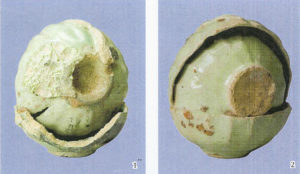
Fig. 28. Pseudo-celadon cup discards from unsuccessful firing in the kilns at the Selitrennoe hillfort. (After: Egorov and Pigarev 2017, 722, figs. 5.1, 2)
In the period of the Golden Horde, celadons produced in various Far Eastern ceramic centers are found in the cities of the Golden Horde located in the Black Sea region along the lower Dnieper, in Transcaucasia and the Northern Caucasus, in Moldova, and along the Volga. In the Golden Horde cities, celadons are found on the premises of the “rich residences, palaces and public buildings” (Tikhomilova 2002: 247). The celadons came into the Golden Horde along the Silk Road (Fedorov-Davydov 2001: 217) or by sea (Raby 1986). Attesting to the popularity of celadons in the Golden Horde is the appearance in Golden Horde cities of the production of pseudo-celadons—kashin ceramic dishes whose shape and glaze color imitate celadons (Bulatov 1968: 108–9; Fedorov-Davydov 1994: 134; Egorov and Pigarev 2017) [Fig. 28]. The celadons that came into Rus’ must have traveled via the cities of the Golden Horde.
Celadons have been found in ten cities of Ancient Rus, located on the territory of Russia and Ukraine: Moscow, Tver’, Kolomna, Riazan’, Velikii Novgorod, Kiev, Chernigov, Nizhnii Novgorod, Vladimir in Volynia, and Lutsk (Koval’ 2010: 134–36; 2017: 758–60). There are dozens of shards, pieces estimated to have come from some 40 to 50 dishes. Among them, the dish of the episcopal court most closely resembles a fragment of the bottom of a dish found in Tver’ [Fig. 29] (Koval’ 2010: 136). The discovery of celadon in Novgorod was first reported in a short communication by Ernest Kondratovich Kverfel’dt (1938: 188). Two small fragments of celadons from Novgorod, found in the strata of the mid-14th and second quarter of the 15th centuries in the Nerev and Trinity excavations, have since been published [Fig. 19 above] (Koval’ 1997a: 159, fig. 2.9; Rodionova and Frenkel’ 2012: 24, ill. 9). The topography of the find of the dish from the episcopal court supports the idea that the celadon belonged to someone from the entourage of the Novgorod archbishop. The fire of 1340 occurred at the time of the archbishopric of Vasilii Kalika (1331–1350). Apparently the last owner of the dish was one of his staff.
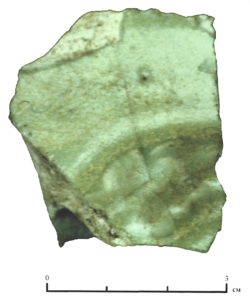
Fig. 29. A fragment from a Longquan celadon dish with underglaze molded décor excavated in Tver’. (After: Koval’ 2010: col. pl. 55:3)
How the Celadon Reached Novgorod
Found in a socially prestigious region of Novgorod, this dish most probably had traveled from a Golden Horde city via another old Russian city, Moscow being the most likely candidate. The association of celadon finds with church circles corresponds well with the circumstances of the celadon finds in Moscow (Koval’ 1997b) and in other old Russian towns (Fekhner 1956: 94; Beliaev 2010: 25, n. 13; Mazurov and Koval’ 2004: 302). To hypothesize that there might have been a connection of the celadon in question with the Moscow Grand Prince, Ivan I Kalita (1288-1340), fits with what we know about the role the Moscow princes began to play as representatives of the political power of the khans in Russian lands and as chief collectors for the tribute which was paid to the Golden Horde. Furthermore, the consolidation of princely power in Moscow was substantially aided by the princes’ close relationship with the Orthodox hierarchs.
Novgorod had managed to escape direct interference by the minions of the Golden Horde in city administration as well as direct military contact with the Horde. The khans dealt but indirectly with the city via their vassals, the early Russian princes to whom they had delegated their military, fiscal, and in part diplomatic functions. Novgorodian merchants could act as middlemen in trade with the Volga region. While a substantial amount of Golden Horde ceramics have been found in Novgorod, dating to the middle and third quarter of the 14th century (Koval’ 1997a: 165; 1998: 169), few of these vessels were the costly celadons imported from across Asia which would have merited special attention. And in fact the date of the deposit of the Longquan dish in the cultural stratum of the episcopal court in 1340 is somewhat earlier than the mass appearance in Novgorod of Golden Horde imported ceramics. The dish itself has to have been produced sometime prior to that year, and one thus has to wonder whether in fact it was an object of trade.
Among the other possible explanations for its acquisition might be river piracy, where Novgorodian river raiders (known as ushkuiniki) acquired a reputation for forays far to the south, in some cases in the vicinity of Golden Horde cities. But the peak of the activity of the ushkuiniki came in periods of political instability and military defeats of the Horde, that is in the last third of the 14th to the 15th centuries. By the last quarter of the 14th century, the quantity of ceramic imports from the Golden Horde in fact gradually diminishes, and none of the ceramic fragments include celadons. So one might think the ushkuiniki would not have valued as trophies such objects as large and heavy celadon vessels. Therefore, if our celadon from the episcopal court was neither a trade good nor a trophy, what other explanation might there be for how it arrived in Novgorod?
Might it have been a gift, in a culture where gifting was an important practice that cemented political and personal alliances? Here is one possible scenario, based on what we know from the chronicles. In 1335, Novgorod was visited for the second time by the Moscow Grand Prince Ivan Kalita. In the same year the Novgorod leadership, including the archbishop, visited Moscow on the invitation of Kalita. In the words of the Novgorod chronicle, “In the same year Bishop Vasilii traveled to Grand Prince Ivan in Moscow to be honored” (PSRL, 43: 111; emphasis added). Historians have noted that in Moscow the representatives of the Novgorod elite—the archbishop, mayor, leader of the thousand, and the elite nobles—were “treated with affection” by the Grand Prince (Solov’ev 1988: 229). It is possible that the celadon came into the hands of someone in the suite of Vasilii Kalika at precisely this moment, and that this person took it back to Novgorod, only to lose it to the fire five years later.
The interest of such a dish may well have derived from its decorative imagery rather than its exotic rarity. In the Old World, a composition such as that of the two fish is polysemic. From early times this composition was one of the signs of the Zodiac. In the Christian world, the depiction of two fish carries a different symbolic meaning, as is evident in the following New Testament quotation: “And he commanded the multitude to sit down on the grass, and took the five loaves, and the two fishes, and looking up to heaven …” [Matthew 14:19, King James version, emphasis added]. In medieval Christian material culture, paired depictions of fish are known, among other places on ceramics. Nadezhda Iur’evna Vishnevskaia has shown convincingly (2009: 338) that “the motif of two fish on a dish is connected with the Gospel theme of the eucharistic feast.”
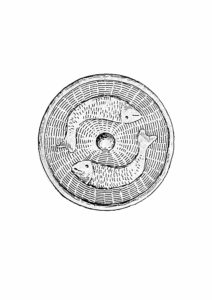
Fig. 30. A type of metal mirror from a nomadic grave, Golden Horde period. (After: Fedorov-Davydov 1966: 79, ris.13, Н1)
We have noted above the meaning of such a composition in China. But in the Golden Horde, too, the given composition was very popular. One type of Golden Horde copper coin has just such a depiction (Lebedev and Klokov 2010: 38, Nos. 125–27; 49, fig. 2/125–27). In the Golden Horde cities of New Sarai, Bolgary, and Biliar and in graves were found round metal mirrors with such a depiction of fish [Fig. 30] (Fedorov-Davydov 1966: 79, fig. 13; Valeev and Rudenko 2005: 178, fig. 6). Scholars have noted that paired depictions of fish on mirrors derive “from Chinese motifs” (Fedorov-Davydov 1994: 203). The precise semantic meaning of this symbol in the Golden Horde milieu is difficult to determine, but possibly might have been similar to the Chinese understanding. Mirrors with paired depictions of fish are known among the Jurchen. Given what we know about the dissemination of mirrors from the Far East in various periods, this suggests one possible mode of transmission of the motif to the Volga region.
We propose then that the presence of the dish with Chinese symbolism in the residence of the Novgorod archbishop can be explained by the Christian reinterpretation of a traditional Chinese symbol. The interactions between the Mongols and their Orthodox subjects in Rus occurred in various ways. Prince Ivan I Kalita made several trips to the Horde in order to secure his position and a guarantee that his heirs would continue to enjoy the khan’s favor. The head of the Russian Church, Metropolitan Peter, who would end his days resident in Moscow, also visited Sarai, where the khan confirmed privileges granted to the Church. Some Russians, willingly or unwillingly, resided in the cities of the Golden Horde, and an Orthodox bishopric had been established there. There is good reason to think that the Mongols and the Russians would have developed some appreciation (if not acceptance) of each other’s cultural values. If “read” according to a Christian cultural code, a celadon that may have been understood very differently by the Mongols thus could have been perceived as having particular value for the Christian elite of the Russian principalities. So it is reasonable to hypothesize how it could have made its way to Moscow, and from there on to Novgorod, where its final owner was a resident of the episcopal court.
– translated by Daniel C. Waugh
About the Authors
Marina Anatol’evna Rodionova is an archaeologist and senior research scholar in the Center of Archaeological Research Organization and Implementation of Novgorod State Museum. Her academic interests encompass the history and the archaeology of medieval Novgorod. For her research on the Novgorod Kremlin, see Rodionova 2011, 2012 and 2017. E-mail: <mariro58@mail.ru>.
Iakov Viktorovich Frenkel’ is an archaeologist and research scholar in the Department of Architectural Archaeology of the State Hermitage Museum, St. Petersburg. His academic interests include the archaeometry of glass, ceramics, and metal, as well as early medieval glass beads and early medieval chronology. For his previous publications relating to the current article, see Frenkel’ and Khavrin 2012; Frenkel’ et al., 2017; and in the latter volume “Khimicheskii sostav srednevekovykh stekol Kremlevskogo raskopa-I” [The Chemical Composition of the medieval glass of the Kremlin Excavation-I], in: Rodionova 2017: 222–25. E-mail: <reserv-jashafrenkel@mail.ru>.
Acknowledgments
We thank the staff of the State Hermitage: T. B. Arapov and K. F. Samosiuk for assistance in work in the collections, S. V. Khavrin for facilitating the archaeometric analysis, V. V. Demiasheva, N. V. Tsareva, and L. G. Kheifits for assistance in preparation of the photo illustrations, N. A. Sutiagin for the translation of Chinese texts. And we are especially grateful to the staff of the library of the Eastern Section. We thank P. G. Gaidukov (Institute of Archaeology of the Russian Academy of Sciences) for the establishment and dating of the numismatic and sphragistics material and O. A. Tarabardin (TsOOAI NGOMZ, Velikii Novgorod) for carrying out the dendrochronological analysis of the planks. We thank Ingmar Jansson (Sweden) for assistance in work in the Royal Library in Stockholm. And our heartfelt thanks to V. Iu. Koval’ (Institute of Archaeology, Russian Academy of Sciences) for his generous consultation.
References
Abilova 1956
Giulli Abil’ kyzy Abilova. “O nakhodkakh seladona v Azerbaidzhane” [On the finds of celadons in Azerbaijan]. Trudy muzeia istorii Azerbaidzhana 1 (Baku, 1956): 56–60 + 2 ill.
Abyzova et al. 1981
Ekaterina Nikolaevna Abyzova, Pavel Petrovich Byrnia, and Avraam Aronovich Nudel’man. Drevnosti Starogo Orkhea. Zolotoordynskii period [The Antiquities of Old Orhei. The Golden Horde Period]. Kishinev, 1981.
Adaksina 1993
Svetlana Borisovna Adaksina. “A. V. Tereshchenko – zabytoe imia v istorii russkoi arkheologii” [A. V. Tereshchenko – a forgotten name in the history of Russian archaeology]. Problemy istorii otechestvennoi arkheologii. Tezisy dokladov konferentsii (11–13 dekabria 1990 g.). Sankt-Peterburg, 1993: 47–48.
Amvrosii 1807
Amvrosii. Istoriia rossiiskoi ierarkhii [A history of the Russian church hierarchy]. Pt. 1. Moskva, 1807.
Arapova 1977
Tat’iana Borisovna Arapova. Kitaiskii farfor v sobranii Ermitazha. Konets XIV-pervaia tret’ XVIII vv. [Chinese porcelain in the Hermitage collection. End of the 14th to the first third of the 18th centuries]. Leningrad, 1977.
Ayers 1978
John Ayers. “The Discovery of a Yüan ship at Sinan, South-West Korea: A First Report.” Oriental Art 24/1 (Spring 1978): 79–85.
Ayers 1985
———. Chinese Ceramics: the Koger Collection. New York: Sotheby’s, 1985.
Ballod 1923
Frants Vladimirovich Ballod. Staryi i Novyi Sarai, stolitsy Zolotoi Ordy. Rezul’taty arkheologicheskikh rabot letom 1922 [Old and New Sarai, the capitals of the Golden Horde. Results of archaeological work in the summer of 1922]. Kazan’, 1923.
Beliaev 2010
Leonid Andreevich Beliaev. “Vostochnye izdeliia’ ili obshcheevropeiskii ‘orientalizm’? O metodicheskikh podkhodakh k kharakteristike islamskikh elementov v kul’ture srednevekovoi Moskvy” [‘Eastern influences’ or ‘Orientalism’ throughout Europe? On approaches for characterizing Islamic elements in the culture of medieval Moscow]. Rus’ i Vostok IX-XVI vv. Novye arkheologicheskie issledovaniia. Moskva, 2010: 19–27.
Brisbane 1992
Mark Brisbane, ed. The Archaeology of Novgorod, Russia. Recent Results from the Town and Hinterland. The Society for Medieval Archaeology Monograph Series: No. 13. Lincoln, 1992.
Brisbane and Gaimster 2001
Mark Brisbane and David R. M. Gaimster. Novgorod: The Archaeology of a Russian Medieval City and Its Hinterland. British Museum Research Publication No. 141. London, 2001.
Brisbane et al. 2012
Mark A. Brisbane, Nikolaj A. Makarov, and Evgenij N.Nosov, eds. The Archaeology of Medieval Novgorod in Context: Studies in Centre/Periphery relations. Oxford, 2012.
Bulatov 1968
Nikolai Mikhailovich Bulatov. “Klassifikatsiia kashinnoi polivnoi keramiki zolotoordynskikh gorodov” [The classification of kashin glazed ceramics of Golden Horde cities]. Sovetskaia arkheologiia, 1968, No. 4: 95–109 + ill.
Bulatov 1969
———. “K voprosu o stanovlenii keramicheskogo remesla v zolotoordynskikh gorodakh” [On the question of the development of ceramic production in Golden Horde cities]. Vestnik Moskovskogo universiteta, Ser. istoriia, 1969, No. 2: 46–59 + 1ll.
Carswell 2000
John Carswell. Blue and White. Chinese Porcelain around the World. London, 2000.
Denike 1929
Boris Petrovich Denike. “Kitaiskaia keramika sredi zolotoordynskikh nakhodok. (Iz sobraniia Tsentral’nogo Muzeia Tatarskoi S.S.R.)” [Chinese ceramics amongst the Golden Horde finds. (From the collection of the Central Museum of the Tatar SSR)]. Materialy Tsentral’nogo Muzeia Tatarskoi S.S.R. (Kazan’), No. 2 (1929): 1–2 + 2 ill.
Evtiukhova 1965
Lidiia Alekseevna Evtiukhova. “Keramika Kara-Koruma” [The ceramics of Karakorum]. In: S. V. Kiselev et al., Drevnemongol’skie goroda. Moskva, 1965: 216–73.
Egorov and Pigarev 2017
Vadim Leonidovich Egorov and Evgenii Mikhailovich Pigarev. “Proizvodstvo psevdoseladona v stolitse Zolotoi Ordy – Sarae” [Production of pseudo-celadon in Sarai, the capital of the Golden Horde]. In: S. G. Bocharov et al., eds., Polivnaia keramika Sredizemnomor’ia i Prichernomor’ia X-XVIII vv. Vol. 2. Kazan’; Kishinev, 2017: 717–24.
Fang 1964
Fang Jie 方杰. Zhejiang Shaoxing Moujiaqiao Song Jing fajue jianbao 浙江紹兴繆家桥宋井发掘簡报 [Brief report on the Song-Jing excavation of Moujiaqiao in Shaoxing, Zhejiang]. Kaogu 考古 1964, No. 11: 558–61.
Fedorov-Davydov 1966
German Alekseevich Fedorov-Davydov. Kochevniki Vostochnoi Evropy pod vlast’iu zolotoordynskikh khanov [Nomads of Eastern Europe under the rule of the khans of the Golden Horde]. Moskva, 1966.
Fedorov-Davydov 1994
———. Zolotoordynskie goroda Povolzh’ia [Golden Horde cities along the Volga]. Moskva, 1994.
Fedorov-Davydov 2001
———. Zolotoordynskie goroda Povolzh’ia. Keramika. Torgovlia. Byt [Golden Horde cities along the Volga. Ceramics. Trade. Way of life]. Moskva, 2001.
Fekhner 1956
Mariia Vasil’evna Fekhner. Torgovlia russkogo gosudarsetva so stranami Vostoka v XVI v. [Trade of the Russian state with countries of the East in the 16th century]. Trudy Gosudarstvennogo Istoricheskogo Muzeia. Vyp. 31. Moskva, 1956.
Frenkel’ and Khavrin 2012
Iakov Viktorovich Frenkel’ and Sergei Vladimirovich Khavrin. “Opyt kul’turno-khronologicheskoy atributsii kitayskogo farfora rentgenoflyuorestsentnym metodom” [Attempt at the cultural and chronological attribution of porcelain by means of the x-ray fluorescence method]. Keramika i farfor Dal’nogo Vostoka: problem stilia i vzaimovliianii. Trudy Goudarstvennogo Ermitazha. Vyp. 59. Sankt-Peterburg, 2012: 160–76.
Frenkel’ et al. 2017
Iakov Viktorovich Frenkel’, Igor’ Viktorovich Volkov, and Marina Anatol’evna Rodionova. “Keramika” [Ceramics]. In: Rodionova 2017: 172–192.
Gadzhiev and Lim Dzhikhën 2011
Murtazali Serazhutdinovich Gadzhiev and Lim Dzhikhën. “Seladon iz raskopok Derbenta i nekotorye voprosy ego rasprostraneniia na Kavkaze i v Vostochnoi Evrope” [A celadon from the excavations of Derbent and some questions about its distribution in the Caucasus and Eastern Europe]. Trudy III (XIX) Vserossiiskogo arkheologicheskogo s”ezda. Vol. 2. Sankt-Peterburg; Moskva; Velikii Novgorod, 2011: 133–35.
Gel’man 1996
Evgeniia Ivanovna Gel’man. Glazurovannia keramika i farfor srednevekovykh pamiatnikov Primor’ia [Glazed ceramics and porcelain of the medieval monuments of Primor’ia (the eastern littoral of Russia)]. Avtoreferat dissertatsii na soiskanie stepeni kandidat istoricheskikh nauk. Vladivostok, 1996.
Gel’man et al. 1996
———, Irina Sergeevna Zhushchikhovskaia and Boris Leonidovich Zalishchak. “K metodike izucheniia srednevekovykh glazurei (po materalam pamiatnikov Primor’ia)” [On the methodology of studying medieval glazes (based on the materials of monuments from the Primor’ia)]. In: I. S. Zhushchikhovskaia et al., eds., Arkheologiia Severnoi Pasifiki. Vladivostok, 1996: 161–68.
Gertsen and Naumenko 2005
Aleksandr Germanovich Gertsen and Valerii Evgen’evich Naumenko. “Polivnaia keramika iz raskopok tsitadeli Mangupa” [Glazed ceramics from eхcavations of the citadel of Mangup]. In: S. G. Bocharov and V. L. Myts, eds., Polivnaia keramika Sredizemnomor’ia i Prichernomor’ia X–XVIII vv. Kiev, 2005: 257–87.
Glukhareva and Denike 1948
Ol’ga Nikolaevna Glukhareva and Boris Petrovich Denike. Kratkaia istoriia iskusstva Kitaia [A short history of Chinese art]. Moskva-Leningrad, 1948.
Glukhov 2014
Aleksandr Anatol’evich Glukhov. “Istoricheskaia topografiia Tsarevskogo gorodishcha” [The historical topography of the Tsarev hillfort]. Povolzhskaia arkheologiia, 2014, No. 2 (8): 92–111.
Gray 1953
Basil Gray. Early Chinese Pottery and Porcelain. London, 1953.
Gubaidullin 2013
Airat Maratovich Gubaidullin. “Issledovaniia v tsentral’noi chasti Bolgarskogo gorodishcha (‘dom remeslennika’)” [Research in the central part of the Bolgar hillfort (‘the house of craftsman’)]. Povolzhskaia arkheologiia, 2013, No. 3 (5): 191–99.
Gudimenko 2005
Gudimenko 2005
Igor’ Viktorovich Gudimenko. “Kitaiskii farfor i glazurovannaia kitaiskaia keramika iz raskopok zolotoordynskogo Azaka” [Chinese porcelain and glazed Chinese ceramics from the excavations of Golden Horde Azak]. In: S.G. Bocharov and V.L. Myts, eds., Polivnaia keramika Sredizemnomor’ia i Prichernomor’ia X–XVIII vv. Kiev, 2005: 178–82.
Gyllensvärd 1975
Bo Gyllensvärd. “Recent finds of Chinese Ceramics at Fostat. II.” Bulletin of the Museum of Far Eastern Antiquities (Stockholm), 47 (1975): 93–125 + 44 plates.
Hobson 1915
Robert Lockhart Hobson. Chinese Pottery and Porcelain: An Account of the Potter’s Art in China from Primitive Times to the Present Day. 2 vols. London, 1915.
Hobson 1924
———. A Guide to the Pottery and Porcelain of the Far East in the Department of Ceramics and Ethnography. London, 1924.
Ianin 1970
Valentin Lavrent’evich Ianin. Aktovye pechati Drevnei Rusi X–XV vv. [Medieval Russian Pendant Seals of the 10th–15th centuries]. Vols. 1–2. Moskva, 1970.
Ianin 2003
———. Novgorodskie posadniki [The Novgorod mayors]. Moskva, 2003.
Ianin 2013
———. Ocherki istorii srednevekovogo Novgoroda [Essays on the history of medieval Novgorod]. Moskva, 2013.
Impey 1999
Oliver Impey. “Chinese Porcelain exported to Japan”. Oriental Art 45/1 (1999): 15–21.
Kalinin 1927
Nikolai Filippovich Kalinin. “Zolotoordynskaia keramika v istoriko-arkheologicheskom otdele Tsentral’nogo Muzeia Tatarskoi S.S.R.” [Golden Horde ceramics in the historical and archaeological section of the Central Museum of the Tatar SSR]. Materialy Tsentral’nogo Muszeia Tatarskoi S.S.R (Kazan’), Vyp. 1 (1927): 10–13 + 1 ill.
Kanevskaia 2004
Nataliia Andreevna Kanevskaia. Traditsionnyi iaponskii farfor XVII-XX veka [Traditional Japanese Porcelain 17th–20th centuries]. Moskva, 2004.
Kerr and Wood 2004
Rose Kerr and Nigel Wood. Science and Civilization in China. Vol. 5. Chemistry and Chemical Technology, Part XII: Ceramic Technology. Cambridge, 2004.
Khudiakov 1916
Mikhail Georgievich Khudiakov. “Keramika” [Ceramics], in: “Otchet o raskopkakh v Bolgarakh v iiule 1914 g.” [Report on the excavations at Bolgary in July 1914]. Izvestiia Obshchestva arkheologii, istorii i etnografii pri Imperatorskom Kazanskom universitete 29/5-6 (1916): 197–230; here, 208–19.
Khudiakov 1919
———. “Kitaiskii farfor iz raskopok 1914 g. v Bolgare” [Chinese porcelain from the 1914 excavations in Bolgar]. Izvestiia Obshchestva arkheologii, istorii i etnografii pri Imperatorskom Kazanskom universitete 30/1 (1919): 117–20.
Kiuner and Dubrovina 1953
Nikolai Vasil’evich Kiuner and Elena Trofimovna Dubrovina. “Drevnii koreiskii farfor iz kollektsii Muzeia antropologii i etnografii” [Early Korean porcelain in the collection of the Museum of Anthropology and Ethnography]. Sbornik Muzeia antropologii i etnografii 15 (1953): 332–56.
Koo 1994
Koo Ill-hoe. “Celadons from the Sinan Coastal Seabed Reconsidered” In: Zhongguo gudai maoyi ci guoji xueshu yantao hui lunwen ji 中國古代貿易瓷國際學術研討會論文集 [International symposium on ancient Chinese trade ceramics: collected papers], Taipei: Guoli lishi bowuguan, 1994: 121–48.
Koval’ 1997a
Vladimir Iur’evich Koval’. “Vostochnaia keramika zolotoordynskoi epokhi v srednevekovom Novgorode” [Eastern ceramics of the Golden Horde period in medieval Novgorod]. Novgorod i Novgorodskaia zemlia. Istoriia i arkheologiia. Vyp. 11. Novgorod, 1997: 153–66.
Koval’ 1997b
———. “Keramika Vostoka v srednevekovoi Moskve (opyt sistematizatsii). Ch. 2. Polumaiolika, farfor, nepolivnaia posudnaia, tekhnicheskaia, dekorativnaia i arkhitekturnaia keramika” [Eastern ceramics in medieval Moscow (an attempt at systematization). Pt. 2. Semi-majolica, porcelain, unglazed vessels, technical, decorative and architectural ceramic]. Rossiiskaia arkheologiia, 1997, No. 3: 94–113.
Koval’ 1998
———. “Vostochnaia polivnaia keramika Il’inskogo raskopa” [Eastern glazed ceramics of the Il’in excavation]. Novgorod i Novgorodskaia zemlia. Istoriia i arkheologiia. Vyp. 12. Novgorod, 1998: 160–70.
Koval’ 2007
———. “Keramika Vostok i Prichernomor’ia v Tverskom Kremle” [Ceramics of the East and the Black Sea littoral in the Tver’ kremlin]. “Polivnaia keramika Vostochnoi Evropy, Prichernomor’ia i Sredizemnomor’ia v X–XVIII vv.” II mezhdunarodnaia konferentsiia (Ialta, 19–23 noiabria 2007 g.) Tezisy konferentsii. Ialta, 2007: 60–62.
Koval’ 2010
———. Keramika Vostoka na Rusi IX–XVII veka [Eastern ceramics in Rus 9th–17th centuries]. Moskva, 2010.
Koval’ 2017
———. “Importnaia glazurovannaia keramika moskovskogo Kremlia (po raskopkam 2007 g.)” [Imported glazed ceramics of the Moscow Kremlin (from the excavations of 2007)]. In: S.G. Bocharov et al., eds., Polivnaia keramika Sredizemnomor’ia i Prichernomor’ia X–XVIII vv. Vol. 2. Kazan’; Kishinev, 2017: 739–63.
Koval’ and Voloshinov 2005
Vladimir Iur’evich Koval’ and Aleksei Aleksandrovich Voloshinov. “Psevdoseladon iz Bakhchisaraia” [Pseudo-celadon from Bahçesarai]. Polivnaia keramika Sredizemnomor’ia i Prichernomor’ia X–XVII vv. Kiev, 2005:457–61.
Krahl 1986
Regina Krahl. Chinese Ceramics in the Topkapi Saray Museum, Istanbul. A Complete Catalogue. 3 vols. London, 1986.
Krahl 1994
———. Chinese Ceramics from the Meiyintang Collection. 2 vols. London. 1994.
Kramarovskii 2005
Mark Grigor’evich Kramarovskii. “Zolotaia Orda kak tsivilizatsiia” [The Golden Horde as a civilization]. Zolotaia Orda. Istoriia i kul’tura. Sankt-Peterburg, 2005: 13–172.
Kramarovskii and Khavrin 1998
———, and Sergei Vladimirovich Khavrin. “Raboty Starokrymskoi arkheologicheskoi ekspeditsii v 1997 g.” [The work of the Old Crimea archaeological expedition in 1997]. Gosudarstvennyi Ermitazh. Otchetnaia arkheologicheskaia sessiia za 1997 god. Tezisy dokladov. Sankt-Peterburg, 1998: 21–25.
Kravchenko 1986
Anastasiia Afanas’evna Kravchenko. Srednevekovyi Belgorod na Dnestre (konets XIII–XIV v.) [Medieval Belgorod on the Dniester River (end of the 13th–14th centuries)]. Kiev, 1986.
Kravchenko 2007
Svetlana Aleksandrovna Kravchenko. “Importnaia glazurovannaia paradnaia keramika iz raskopok Azaka” [Imported glazed ceremonial ceramics from the Azak excavations].“Polivnaia keramika Vostochnoi Evropy, Prichernomor’ia i Sredizemnomor’ia v X–XVIII vv.” II mezhdunarodnaia konferentsiia (Ialta, 19–23 noiabria 2007 g.) Tezisy konferentsii. Ialta, 2007: 63–65.
Kuz’menko 2009
Larisa Ivanovna Kuz’menko. Kitaiskii farfor XVII–XVIII vv. [Chinese porcelain of the 17th–18th centuries]. Moskva, 2009.
Kverfel’dt 1938
Ernest Kondratovich Kverfel’dt. “Kitaiskaia keramika XII–XII vv. na Kavkaze” [Chinese ceramics of the 12th–13th centuries in the Caucasus]. Pamiatniki epokhi Rustaveli. Leningrad, 1938: 185–94.
Kverfel’dt 1947
———. Keramika Blizhnego Vostoka: rukovodstvo k raspoznaniiu i opredeleniiu keramicheskikh izdelii [Middle Eastern Ceramics: a guide to the identification and definition of ceramic wares]. Leningrad, 1947.
Lapshin 2009
Vladimir Anatol’evich Lapshin. Tver’ v XIII–XV vv. (po materialam raskopok 1993–1997) [Tver’ in the 13th–15th centuries (from the materials of the 1993–1997 excavations)]. Sankt-Peterburg, 2009.
Lebedev and Klokov 2001
Valentin Petrovich Lebedev and Vasilii Borisovich Klokov. “Monety s iugo-vostochnykh okrain Saraia” [Coins from the southeastern borders of Sarai]. Tatarskaia arkheologiia /Tatar Arkheologiiase (Kazan’), 2001, No. 1–2 (8–9): 19–46.
Li 1985
Li Hu Hou. “Characteristic Elements of Longquan Greenware”. Archaeometry 27/1 (1985): 53–60.
Liu and Xiong 1982
Liu Yuhei 刘裕黑, Xiong Lin 熊琳. “Jiangxi Gao’an xian faxian Yuan qinghua, youlihong deng ciqi jiaocang” 江西高安县发现元青花, 釉里红等瓷器窖藏 [A deposit of porcelain with green glaze and red glaze found in Gao’an County, Jiangxi Province]. Wenwu 文物, 1982, No. 4: 58–69 + 2 pls.
Lubo-Lesnichenko 1973
Evgenii Iosifovich Lubo-Lesnichenko. Privoznye zerkala minusinskoi kotloviny. K voprosu o vneshnikh sviaziakh drevnego naseleniia Iuzhnoi Sibiri [Imported mirrors of the Minusinsk Basin. On the question of the external connections of the ancient population of Southern Siberia]. Moskva, 1975.
Makarii 1860
Makarii. Arkheologicheskoe opisanie tserkovnykh drevnostei v Novgorode i ego okrestnostiakh [An archaeological description of church antiquities in Novgorod and its environs]. Ch. 1. Moskva, 1860.
Mazurov and Koval’ 2004
Aleksei Borisovich Mazurov and Vladimir Iur’evich Koval’. “Keramicheskii import srednevekovoi Kolomny” [Ceramic imports of medieval Kolomna]. Arkheologiia Podmoskov’ia. Materialy nauchnogo seminara. Moskva, 2004: 285–308.
Medley 1982
Margaret Medley.The Chinese Potter. A Practical History of Chinese Ceramics. Ithaca, NY, 1982.
Morgan 1991
Peter Morgan. “New Thoughts on old Hormuz: Chinese Ceramics in the Hormuz Region in the Thirteenth and Fourteenth Centuries.” Iran: Journal of the British Institute of Persian Studies 29 (1991): 67–83 + pls. IV–VII.
Musin and Stepanov 2007
Alaksandr Evgen’evich Musin and Andrei Mikhailovich Stepanov. “Lozhka ili lzhitsa? Nakhodka 2005 g. na Troitskom raskope v kontekste evropeiskoi i vizantiiskoi traditsii” [A table spoon or a communion spoon? A find in 2005 in the Trinity excavation in the context of European and Byantine tradition]. Novgorod i Novgorodskaia zemlia. Istoriia i arkheologiia. Vyp. 21. Novgorod 2007: 107–24.
Nosov et al. 2017
Nosov et al. 2017
Evgenii Nikolaevich Nosov, Aleksei Viacheslavovich Plokhov, and Natal’ia Vadimovna Khvoshchinskaia. Riurikovo gorodishche. Novye etapy issledovanii. Sankt-Peterburg, 2017.
NPL1950
NPL 1950
Novgorodskaia pervaia letopis’ starshego i mladshego izvodov [The Novgorod First Chronicle in its older and younger redactions]. Moskva-Leningrad, 1950.
Obukhov and Volkov 2007
Iurii Dmitrievich Obukhov and Igor’ Viktorovich Volkov. “Kitaiskaia keramika iz Madzhara” [Chinese ceramics from Madzhar]. In: S.G. Bocharov and V. Iu. Koval’, eds., “Polivnaia keramika Vostochnoi Evropy, Prichernomor’ia i Sredizemnomor’ia v X–XVIII vv.” II mezhdunarodnaia konferentsiia (Ialta, 19–23 noiabria 2007 g.) Tezisy konferentsii. Ialta, 2007: 21–24.
Ozheredov et al. 2008
Iurii Ivanovich Ozheredov, Liudmila Mikhailovna Pletneva, and Tetsu Masumoto. “Metallicheskie zerkala v Muzee arkheologii i etnografii Sibiri im. V. M. Florinskogo TGU: formirovanie i issledovanie sobraniia” [Metal mirrors in the V. M. Florinskii Museum of Archaeology and Ethnography of Sibieria of TGU: the formation and study of the collection]. Kul’tury i narody Severnоi Azii i sopredel’nykh territorii v kontekste mezhdistsiplinarnogo izucheniia. Sbornik Мuzeia arkheologii i etnografii Sibiri im. V. M. Florinskogo. Vyp. 2. Tomsk, 2008: 136–57.
Palmgren 1963
Nils Palmgren. Sung Sherds. Stockholm, 1963.
Pierson 1996
Stacey Pierson. Earth, Fire and Water: Chinese Ceramic Technology. A Handbook for Non-Specialists. London, 1996.
Pirazzoli-t’Serstevens 1988
Michèle Pirazzoli-t’Serstevens. “La céramique chinoise de Qal’at al-Ṣuḥâr.” Arts Asiatiques: Annales du musée Guimet et du musée Cernuschi 43 (1988): 87–105.
Poluboiarinova 2003
Marina Dmitrievna Poluboiarinova. “Kitaiskii seladon iz Bolgara” [A Chinese celadon from Bolgar]. Rossiiskaia arkheologiia, 2003, No. 2: 155–64.
PSRL
Polnoe sobranie russkikh letopisei [The Complete Collection of Russian Annals]:
Vol. 3. Novgorodskaia tret’ia letopis’. S.-Peterburg, 1841.
Vol. 7. Voskresenskaia letopis’. S.-Peterburg, 1856.
Vol. 43. Novgorodskaia letopis’ po spisku P. P. Dubrovskogo. Moskva, 2004.
Raby 1986
Julian Raby. “The Porcelain Trade Routes”. In: Krahl 1986, Vol. I: 55–63.
Raby and Yücel 1983
———, and Ünsal Yücel. “Blue-and-white, Celadon and Whitewares: Iznik’s Debt to China”. Oriental Art 29/1 (1983): 38–48.
Rodionova 2011
Rodionova 2011
Marina Anatol’evna Rodionova. “Itogi arkheologicheskikh issledovanii na Vladychnom dvore v Novgorodskom kremle (Krelevskii raskop 2008-2010 gg.)” [Results of the archaeological studies in the Episcopal court of the Novgorod Kremlin (the Kremlin excavation of 2008-2010). Novgorod i Novgorodskaia zemlia. Istoriia i arkheologiia. Vyp. 25. Velikii Novgorod, 2011): 44–57.
Rodionova 2017
Marina Anatol’evna Rodionova. Novgorodskii detinets i vladychnyi dvor v XI–XV vv. [The Novgorod castle and episcopal court in the 11th–15th centuries]. Sankt-Peterburg, 2017.
Rodionova and Frenkel’ 2012
Marina Anatol’evna Rodionova and Iakov Viktorovich Frenkel’. “Kitaiskii seladon iz Novgorodskogo kremlia” [A Chinese celadon from the Novgorod Kremlin]. Keramika i farfor Dal’nogo Vostoka: problem stilia i vzaimovliianii. Trudy Goudarstvennogo Ermitazha. Vyp. 59. Sankt-Peterburg, 2012: 8–38.
Rybina 2009
Elena Aleksandrovna Rybina. Novgorod i Ganza [Novgorod and the Hanseatic League]. Moskva, 2009.
Ryōichi 1990
Ryōichi Fujioka. “A survey history of Chinese ceramics”. In: Osaka Shiritsu Toyo Toji Bijutsukan 編集大阪市立東洋陶磁美術館[Osaka Museum of Oriental Ceramics],Toyo toji no tenkai 東洋陶磁の展開/ Masterpieces of Oriental Ceramics. Osaka, 1990: 179–89.
Shavkunov 1960
Ernst Vladimirovich Shavkunov. “Klad chzhurchzhen’skikh zerkal”. Trudy dal’nevostochnoi arkheologicheskoi ekspeditsii, Vol. 1. Materialy i issledovaniia po arkheologii SSSR. (MIA No. 86). Moskva-Leningrad, 1960: 231–37.
Shelkovnikov 1954
Boris Aleksandrovich Shelkovnikov. “Kitaiskaia keramika iz raskopok srednevekovykh gorodov i poselenii Zakavkaz’ia” [Chinese ceramics from excavations of medieval cities and settlements in Transcaucasia]. Sovetskaia arkheologiia 21 (1954): 368–78 + 5 ill.
Shtern 1901
Ernst Romanovich fon Shtern. “O poslednikh raskopkakh v Akkermane” [On the last excavations at Akkerman]. Zapiski imperatorskogo Odesskogo Obshchestva Istorii i Drevnostei 23 (1901): 33–61.
Sinan 2016
Sinan haejŏsŏn esŏ ch’ajanaen kŏttŭl: palgul 40-chunyŏn kinyŏm t’ŭkpyŏlchŏn 신안해저선에서찾아낸것들: 발굴40 주년기념특별전[Discoveries from the Sinan Shipwreck: Special Exhibition on the 40th Anniversary of the Excavation]. Seoul: Kungnip Chungang Pangmulgwan, 2016.
Solov’ev 1988
Sergei Mikhailovich Solov’ev. Istoriia Rossii s drevneishikh vremen [A history of Russia from ancient times]. Vols. 3–4. Moskva, 1988.
Stuzhina 1970
Emiliia Pavlovna Stuzhina. Kitaiskoe remeslo v XVI–XVIII vekakh [Chinese crafts in the 16th–18th centuries]. Moskva, 1970.
Tereshchenko 1850
Aleksandr Vlas’evich Tereshchenko. “Arkheologicheskie poiski v razvalinakh Saraia (iz otchetov A. V. Tereshchenko)” [Archaeological Searches in the ruins of Sarai (from the reports by A. V. Tereshchenko)]. Zapiski Sankt-Peterburgskogo Arkheologo-numismaticheskogo obshchestva 2 (1850): 364–410.
Thompson 1967
Michael Welman Thompson. Novgorod the Great: Excavations at the Medieval City Directed by A. V. Artsikhovsky and B. A. Kolchin. New York, 1967.
Tikhomolova 2002
Irina Romanovna Tikhomоlova. “Farfor i faians v keramicheskom komplekse gorodishchea Bol’shie Kuchugury” [Porcelain and faience in the ceramic complex of the Bol’shie Kuchugury hillfort]. Starozhitnosti stepovogo prichornomor’ia i Krymu (Zaporizhzhia). Vyp. 10 (2002): 239–51.
Tokyo 1994
Tokyo Kokuritsu Hakubutsukan. Chinese Ceramics: Special Exhibition. Tokyo: Tokyo National Museum, 1994.
Troinitskii 1911
Sergei Nikolaevich Troinitskii. “Galereia farfora Imperatorskogo Ermitazha” [The porcelain gallery of the Imperial Hermitage]. Starye gody, 1911, mai: 3–28.
Valeev and Rudenko 2005
Ramil’ Mirgasimovich Valeev and Konstantin Aleksandrovich Rudenko. “Material’naia kul’tura naseleniia Bulgarskogo Ulusa Zolotoi Ordy v XIII–XIV vv.” [The material culture of the population of the Bulgar ulus of the Golden Horde in the 13th–14th centuries]. Zolotaia Orda. Istoriia i kul’tura. Sankt-Peterburg, 2005: 173–91.
Valenstein 1989
Suzanne G. Valenstein. A Handbook of Chinese Ceramics. New York, 1989.
Valiulina 2000
Svetlana Igorevna Valiulina. “Issledovanie zolotoordynskogo Biliara” [The study of Golden Horde Biliar]. Nauchnoe nasledie A. P. Smirnova i sovremennye problem arkheologii Volgo-Kam’ia. Materialy nauchnoi konferentsii. Trudy Gosudarstvennogo istoricheskogo muzeia, Vyp. 122. Moskva, 2000: 273–85.
Valiulina 2010
———. “Mezhdunarodnye sviazi rannego Kazanskogo khanstva po materialam Toretskogo poseleniia” [International links of the early Kazan’ khanate, based on materials from the Toretsk settlement]. Rus’ i Vostok IX–XVI vv. Novye arkheologicheskie issledovaniia. Moskva, 2010: 183–91.
Vasil’ev 1878
Vasilii Pavlovich Vasil’ev. “O zamechatel’noi kitaiskoi monete kontsa X ili nachala XI veka, priobretennoi v sele Bolgarakh v avguste 1877 goda” [On the remarkable Chinese coin of the end of the 10th or beginning of the 11th century obtained in the village of Bolgary in August 1877]. Izvestiia Obshchestva arkheologii, istorii i etnografii pri Imperatorskom Kazanskom universitete. Vol. 1, Vyp. 3. Kazan’, 1878: 122–23.
Vestfalen and Krechetova 1947
El’za Khristianovna Vestfalen and Marianna Nikolaevna Krechetova. Kitaiskii farfor [Chinese porcelain]. Leningrad, 1947.
Vishnevskaia 2009
Nadezhda Iur’evna Vishnevskaia. “Glazurovannoe bliudo X v. iz Samarkanda s izobrazheniem ryb” [A glazed 10th-century dish from Samarkand with an image of a fish]. In: L.A. Beliaev, ed., Archeologia Abrahamica. Issledovaniia v oblasti arkheologii i khudozhestvennoi traditsii iudaizma, khristianstva i islama. Moskva, 2009: 333–41.
Wang 2002
Wang Qingzheng. A Dictionary of Chinese Ceramics. Tr. by Lillian Chin and Jay Xu. New ed. Singapore, 2002.
Wirgin 1970
Jan C. Wirgin. Sung Ceramic Designs. Bulletin of The Museum of Far Eastern Antiquities, No. 42. Stockholm, 1970.
Wood 2011
Nigel Wood. Chinese Glazes. Their Origins, Chemistry, and Recreation. London; Philadelphia, 2011.
Xia 1963
Xia Nai 夏鼐. “Zuowei gudai Zhong Fei jiaotong guanxi zhengju de ciqi” 作为古代中非交通关系证据的瓷器 [Porcelain as evidence of ancient Sino-African trade]. Wenwu 文物, 1963, No. 1: 15–19.
Xie et al. 2009
Xie Guoxi, Feng Songlin, Feng Xiangqian, et al. “The dating of Ancient Chinese celadon by INAA and Pattern Recognition methods.” Archaeometry 51, no. 4 (2009): 682–99.
Yu and Mei 1989
Yu Jiadong 余家栋 and Mei Shaoqiu 梅绍裘. “Jiangxi Lean faxian Yuan dai ciqi jiaocang” 江西乐安发现元代瓷器窖藏 [A deposit of Yuan-period porcelain found in the region of Lean city in Jiangxi Province]. Wenwu 文物, 1989, No. 1: 75–87, 17.
Zhang 1987
Zhang Beichao 张北超. “Hunan Taojiang faxian Longquan yao ciqi jiaocang” 湖南桃江发现龙泉窑瓷器窖藏 [Discovery of Longquan kiln porcelain in Taojiang, Hunan Province]. Wenwu 文物, 1987, No. 9: 21–24.
Zhu and Wang 1963
Zhu Boqian 朱伯谦, Wang Shilun 王士伦 .“Zhejiang sheng Longquan qing ciyao zhi diaocha fajue de zhuyao shouhuo” 浙江省龙泉青瓷窑址调查发掘的主要收获 [The main result of the investigation and excavation of the Longquan celadon kiln site in Zhejiang Province]. Wenwu 文物, 1963, No. 1: 27–39.
Zhushchikhovskaia 2015
Irina Sergeevna Zhushchikhovskaia. “Koreitsy Rossiiskogo Primor’ia v 60-kh godakh XIX v. – 30-kh godakh XX veka: keramicheskaia i farforovaia posuda v kontekste kul’turnykh traditsii” [Koreans of the Russian Primore’ia in the 1860s–1930s: ceramic and porcelain wares in the context of cultural tradition]. Integratsiia arkheologicheskikh i etnograficheskikh issledovanii. Sbornik nauchnykh trudov. Barnaul; Omsk, 2015: 188–92.
Zilivinskaia 2008
Emma Davidovna Zilivinskaia. “Raskopki usad’by na Krasnom burge Selitrennogo gorodishcha” [Excavations of the residence on the Red Hill of the Selitrennoe hillfort]. Stepi Evropy v epokhu srednevekov’ia. Zolotoordynskoe vremia. Vol. 6. Donetsk, 2008: 17–93.
Zolotaia orda 2005
Zolotaia orda. Istoriia i kul’tura [The Golden Horde. History and culture]. Sankt-Peterburg, 2005.

